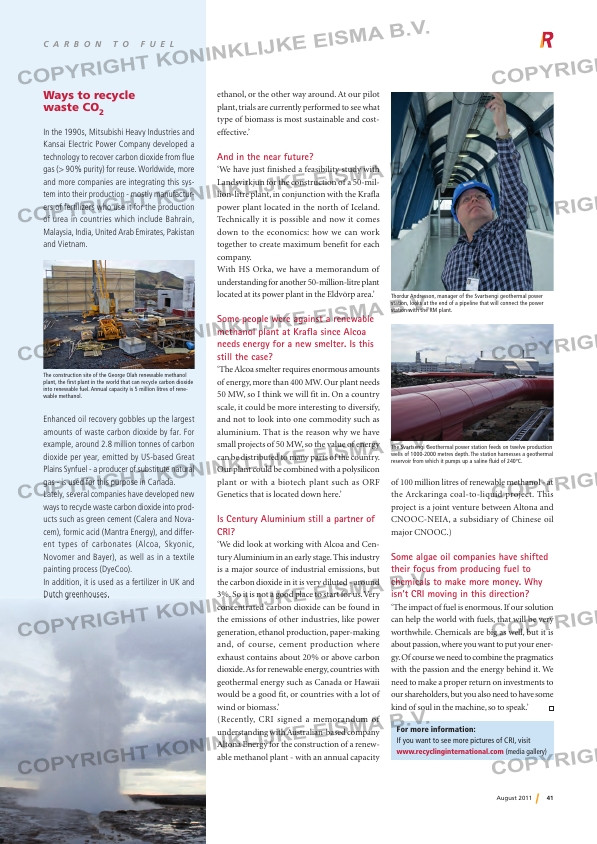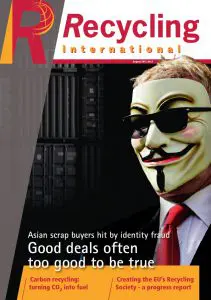Page 41 from: August 2011

41August 2011
Ways to recycle
waste CO2
In the 1990s, Mitsubishi Heavy Industries and
Kansai Electric Power Company developed a
technology to recover carbon dioxide from fl ue
gas (> 90% purity) for reuse. Worldwide, more
and more companies are integrating this sys-
tem into their production – mostly manufactur-
ers of fertilizers who use it for the production
of urea in countries which include Bahrain,
Malaysia, India, United Arab Emirates, Pakistan
and Vietnam.
Enhanced oil recovery gobbles up the largest
amounts of waste carbon dioxide by far. For
example, around 2.8 million tonnes of carbon
dioxide per year, emitted by US-based Great
Plains Synfuel – a producer of substitute natural
gas – is used for this purpose in Canada.
Lately, several companies have developed new
ways to recycle waste carbon dioxide into prod-
ucts such as green cement (Calera and Nova-
cem), formic acid (Mantra Energy), and differ-
ent types of carbonates (Alcoa, Skyonic,
Novomer and Bayer), as well as in a textile
painting process (DyeCoo).
In addition, it is used as a fertilizer in UK and
Dutch greenhouses.
ethanol, or the other way around. At our pilot
plant, trials are currently performed to see what
type of biomass is most sustainable and cost-
effective.’
And in the near future?
‘We have just finished a feasibility study with
Landsvirkjun for the construction of a 50-mil-
lion-litre plant, in conjunction with the Krafla
power plant located in the north of Iceland.
Technically it is possible and now it comes
down to the economics: how we can work
together to create maximum benefit for each
company.
With HS Orka, we have a memorandum of
understanding for another 50-million-litre plant
located at its power plant in the Eldvörp area.’
Some people were against a renewable
methanol plant at Krafla since Alcoa
needs energy for a new smelter. Is this
still the case?
‘The Alcoa smelter requires enormous amounts
of energy, more than 400 MW. Our plant needs
50 MW, so I think we will fit in. On a country
scale, it could be more interesting to diversify,
and not to look into one commodity such as
aluminium. That is the reason why we have
small projects of 50 MW, so the value of energy
can be distributed to many parts of the country.
Our plant could be combined with a polysilicon
plant or with a biotech plant such as ORF
Genetics that is located down here.’
Is Century Aluminium still a partner of
CRI?
‘We did look at working with Alcoa and Cen-
tury Aluminium in an early stage. This industry
is a major source of industrial emissions, but
the carbon dioxide in it is very diluted – around
3%. So it is not a good place to start for us. Very
concentrated carbon dioxide can be found in
the emissions of other industries, like power
generation, ethanol production, paper-making
and, of course, cement production where
exhaust contains about 20% or above carbon
dioxide. As for renewable energy, countries with
geothermal energy such as Canada or Hawaii
would be a good fit, or countries with a lot of
wind or biomass.’
(Recently, CRI signed a memorandum of
understanding with Australian-based company
Altona Energy for the construction of a renew-
able methanol plant – with an annual capacity
of 100 million litres of renewable methanol – at
the Arckaringa coal-to-liquid project. This
project is a joint venture between Altona and
CNOOC-NEIA, a subsidiary of Chinese oil
major CNOOC.)
Some algae oil companies have shifted
their focus from producing fuel to
chemicals to make more money. Why
isn’t CRI moving in this direction?
‘The impact of fuel is enormous. If our solution
can help the world with fuels, that will be very
worthwhile. Chemicals are big as well, but it is
about passion, where you want to put your ener-
gy. Of course we need to combine the pragmatics
with the passion and the energy behind it. We
need to make a proper return on investments to
our shareholders, but you also need to have some
kind of soul in the machine, so to speak.’
The construction site of the George Olah renewable methanol
plant, the fi rst plant in the world that can recycle carbon dioxide
into renewable fuel. Annual capacity is 5 million litres of rene-
wable methanol.
The Svartsengi Geothermal power station feeds on twelve production
wells of 1000-2000 metres depth. The station harnesses a geothermal
reservoir from which it pumps up a saline fl uid of 240ºC.
C A R B O N T O F U E L
Thordur Andresson, manager of the Svartsengi geothermal power
station, looks at the end of a pipeline that will connect the power
station with the RM plant.
For more information:
If you want to see more pictures of CRI, visit
www.recyclinginternational.com (media gallery)
p034_CO2 Recycling.indd 41 10-08-11 08:43



